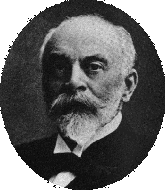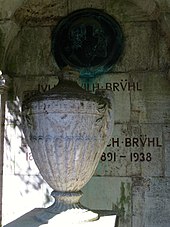Julius Wilhelm Brühl
Julius Wilhelm Brühl (born February 13, 1850 in Warsaw , † February 5, 1911 in Heidelberg ) was a chemist and creator of organic spectrochemistry .


Life
His parents were the industrialist Ludwig Brühl (1821–1867) and Emma, b. Bamberg. In addition to his brother Ariel (* 1851), he had three younger siblings. From 1859 he attended the Herrnhuter Knabenanstalt in Gnadenberg (Silesia) and in 1866/67 the commercial school in Berlin. After the early death of his father, on the advice of his uncle, the sugar manufacturer Theodor Bamberg, he studied chemistry at the Polytechnic in Zurich from 1868–70 , then in Berlin with August Wilhelm von Hofmann and Georg Hermann Quincke . In 1873 he followed Hans Heinrich Landolt as an assistant to Aachen, where he became a private lecturer. In 1875 he received his doctorate from the University of Göttingen .
In 1880 he moved to Lemberg, 1884 to Freiburg im Breisgau and in 1888 he succeeded August Bernthsen at the University of Heidelberg . Although he retired in 1898, he worked in his private laboratory until 1907. In the winter of 1880/81 he married Elisabeth (Lili) Bamberger (1857-1931), with whom he had a daughter and son Felix Johann Rudolf Erich Brühl (1891-1938) who died early.
research
From 1880 he worked in the field of spectrochemistry (researching the constitution of chemical compounds with the help of refraction and dispersion). He was able to prove that the previously observed deviations of chemical bodies from the law of Gladstone and Dale from 1858 is always related to multiple bonds in the molecule. He could not establish a simple relationship between refraction and dispersion. Molecular volume and refraction appeared to be closely related quantities, since both are proportional to the space occupied by the molecules. This work contributed a lot to the knowledge of terpenes .
Publications
- The plant alkaloids , F. Vieweg , Braunschweig 1900 (entry at openlibrary.org )
literature
- Walter Gerlach: Brühl, Julius Wilhelm. In: New German Biography (NDB). Volume 2, Duncker & Humblot, Berlin 1955, ISBN 3-428-00183-4 , p. 663 ( digitized version ).
- Dagmar Drüll: Heidelberger Gelehrtenlexikon 1803-1932 . (Ed.): Rector of the Ruprecht-Karls-Universität-Heidelberg. Springer Berlin Heidelberg Tokyo. 2012. 324 pp. ISBN 978-3642707612
Individual evidence
- ↑ Alexander Kipnis: Brühl, Julius Wilhelm In: Badische Biographien NF 5, pp. 31–33.
- ↑ Ludwig Darmstaedter: Handbook for the History of Natural Sciences and Technology 1866 , p. 777 (PDF, 2.7 MB)
| personal data | |
|---|---|
| SURNAME | Brühl, Julius Wilhelm |
| BRIEF DESCRIPTION | Chemist |
| DATE OF BIRTH | February 13, 1850 |
| PLACE OF BIRTH | Warsaw |
| DATE OF DEATH | February 5, 1911 |
| Place of death | Heidelberg |

